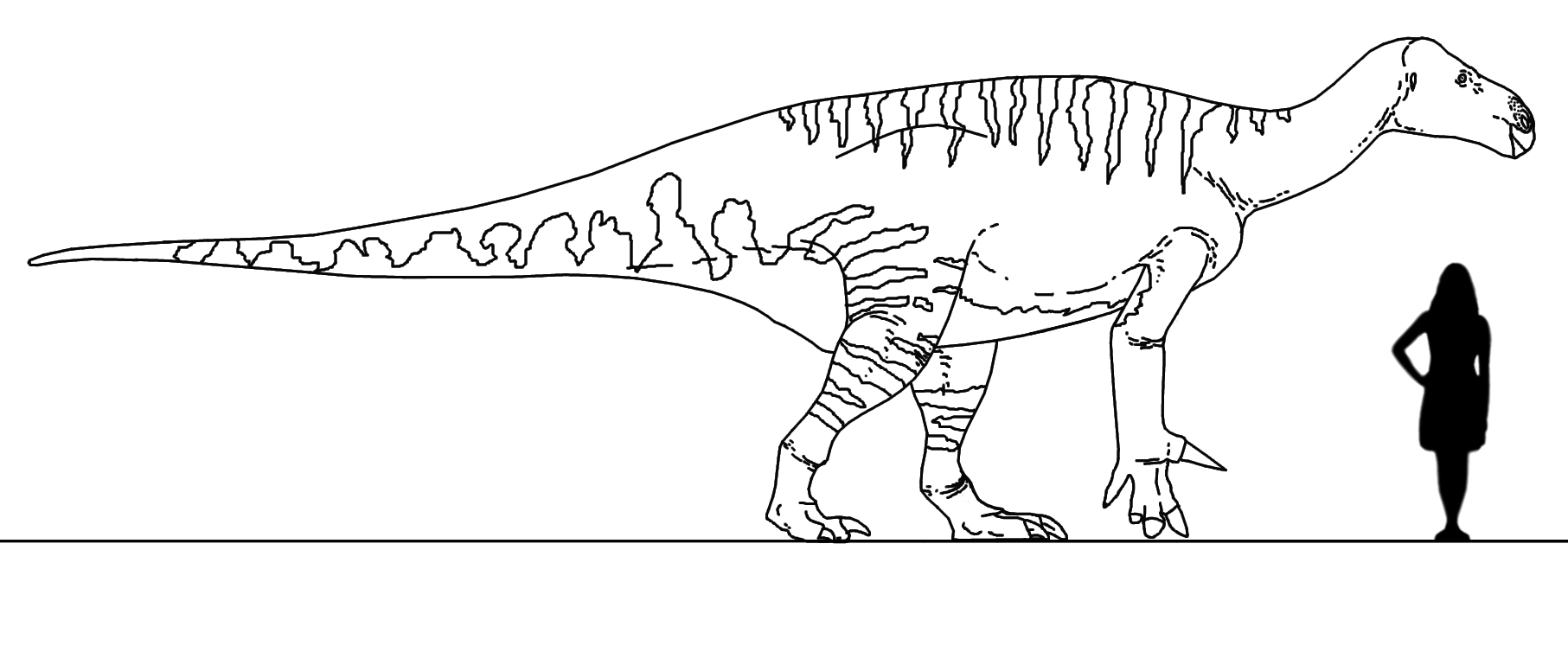HOME | DD
 randomdinos — Stem-Bird Files: Iguanodon
randomdinos — Stem-Bird Files: Iguanodon

#iguanodontia #hadrosauriformes #iguanodonbernissartensis #dryomorpha #ankylopollexia
Published: 2016-03-28 01:33:49 +0000 UTC; Views: 5718; Favourites: 101; Downloads: 21
Redirect to original
Description
Iguanodontia>Dryomorpha>Ankylopollexia>Hadrosauriformes>Iguanodon>I.bernissartensisBoulenger, 1881
Time: Late Barremian (126-125 million years ago)
Length: Up to 9.5 meters (31.1ft) when fully grown.
Height: Up to 2.7 meters (8.8ft) at the hip when fully grown.
Weight: Up to 4.8 tonnes when fully grown.
Habitat: The region of Bernissart in Belgium, Europe; possibly other locations within the continent.
Ecology: Large terrestrial herbivore. Like other hadrosauriformes, Iguanodon had a keratinous beak structure for cropping twigs and leaves, and a primitive form of chewing to break it down within the mouth, and the flexible little finger could have helped gather foliage or grasp tree trunks or other objects.
Diet: Tree-level foliage, perhaps up to 4 meters off the ground. Probably ate horsetails, cycads, and conifers, as well as young angiosperm trees.
Locomotion: While initially interpreted as an obligate quadruped, then a triped and then a biped, it was most likely a facultative biped, though adults likely spent more time on all fours. Juvenile I.bernissartensis show proportionally shorter arms than adults, implying a mostly bipedal lifestyle as they were younger. The maximum speed of Iguanodon is estimated, on a bipedal gait, to be around 25 kph (15 miles per hour).
Social behavior: Although sometimes interpreted as the result of a single catastrophe, the Bernissart finds of 38 Iguanodon skeletons are now interpreted as recording multiple events. According to this interpretation, at least three occasions of mortality are recorded, and though numerous individuals would have died in a geologically short time span, this does not necessarily mean they were all in large herds/groupd during the occasion.
Potential predators: As juveniles, contemporary tyrannosauroid Eotyrannus and spinosaurid Baryonyx. Their bulk probably protected a grown adult from either of these theropods, but most adults would still be susceptible to attacks from Neovenator.
----------------------------------------------------------------------------------------------------------------------------------------------------------------------------
Update 07/14/17:
-Lineart completely remade.
-Replaced human scale figure.
-More accurate size estimate, now along the centra as is the norm, instead of in a straight line.
-Updated common name (let's be honest, ''Iguanodon'' is much more memorable than ''Bernissartian Iguana Tooth'', that name was terrible)
-Minor text corrections.
Skeletal reconstruction by
Related content
Comments: 32

Well these claws ain't just for mating!
👍: 0 ⏩: 1

Is mayonnaise an instrument?
👍: 0 ⏩: 1

Welp, we have the new Stegosaurus here...
Anyways, awesome!
👍: 0 ⏩: 1

New Stegosaurus?
And thanks!
👍: 0 ⏩: 1

It got a length increase, but a mass decrease.
Anyways, you're welcome!
👍: 0 ⏩: 0

There's also an unnamed velociraptorine dromaeosaur that's known from only a single tooth found in the Wessex Formation in Isle of Wight, England and judging from the size of the tooth, the raptor dinosaur would've been similar in size to Utahraptor! news.bbc.co.uk/2/hi/science/na…
👍: 0 ⏩: 2

Oooh! Is that what WWD's European Utahraptors inspired from??
👍: 0 ⏩: 1

I think so! I mean that could explain it perhaps
👍: 0 ⏩: 0

Lies! All lies! It could be a proceratosaur (unlikely, seeing how we've found Dromaeosaurs from the formation, but not other tyrannosaurs)
👍: 0 ⏩: 0

I really like this one, accurate. Can you do a saurolophus plez
👍: 0 ⏩: 1

How would he react if he saw stuff on Facebook?
👍: 0 ⏩: 1

Either bend his arm 45 degrees up, or turn his back against the post and bend it 45 degrees down.
👍: 0 ⏩: 1

You mentioned Baryonyx. If the claim that Spino's legs are itty-bitty hold water (no pun intended), then the other spinosaurs, like Baryonyx, should have had the same leg size. Yet Spino was, as far as we know, the sole exception. Why could that be?
👍: 0 ⏩: 1

Spinosaurus wasn't alone in its leg proportions; Sigilmassasaurus had them the same.
This may have to do with their different lifestyles or their position in the Spinosauridae family tree. (Baryonychines vs. Spinosaurines)
👍: 0 ⏩: 1

Baryonychines were more generalistic, while spinosaurines were more specialized.
👍: 0 ⏩: 1

So, by that statement, Irritator and Siamosaurus were more closely related to the Heavy Claw than Spinosaurus?
👍: 0 ⏩: 1

Of all spinosaurids, Siamosaurus teeth have the highest evidence of oxygen isotopes pointing towards life in water (more so than Spinosaurus itself).
Isotope ratios from teeth from the spinosaurids Baryonyx , Irritator , Siamosaurus, and Spinosaurus were compared with isotopic compositions from contemporaneous theropods, turtles, and crocodilians. The study found that, among theropods, spinosaurid isotope ratios were closer to those of turtles and crocodilians. Siamosaurus specimens tended to have the largest difference from the ratios of other theropods
Irritator was the black sheep of the subfamily since it was more baryonychine-like in its feeding, but it's more closely related to Spino.
👍: 0 ⏩: 1

So what does it mean for Spino? That it spent time on land outside the nesting season?
👍: 0 ⏩: 1

Probably, yeah. While the isotope analysis cannot be 100% reliable (you can imagine the margin of error when all you have to go by are teeth), Spinosaurus wasn't a huge oddball in its family when it came to living in water, and was actually less so than others. From my point of view it probably spent several hours a day lazing off on muddy beaches like turtles or crocodiles, since a fully grown adult probably didn't have much to look out for (and even then, by staying close to the water you'd be assuring that you're not too far away from your turf when threatened, and can make a hasty retreat).
👍: 0 ⏩: 0

A THUMBS UP for this
Yeah that joke was bad. Verry bad.
👍: 0 ⏩: 1

A thumbs angled 45 degrees away from the position of your hand
👍: 0 ⏩: 1

A thumbs stabbing theropod bullies
👍: 0 ⏩: 0



























